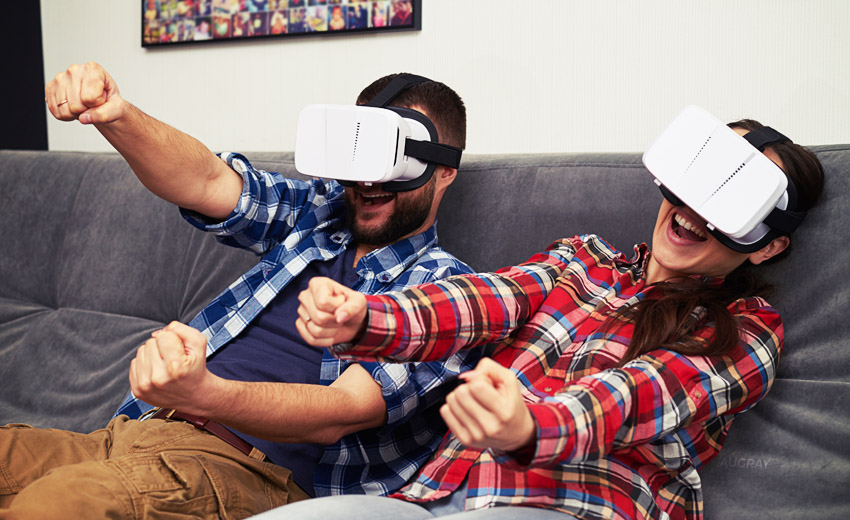The informative guide to understanding VR technology, it’s use cases and the future scope.
Want to explore a world all your own? Want to fly beyond the skies? Perhaps you just want to relax in a perfect zen garden. Virtual Reality is your ticket to all of those experiences and more. In the recent past, only gamers have been familiar with the term. However, VR has also attempted to make inroads into the mainstream sectors, such as the pharma and educational sectors. Like its AR cousin, it definitely shows promise as a technology. Can it go the distance, though? Make your guesses now, because that’s what we’re going to decode today!
Similar Simulations in VR
For starters, let’s clear the air about a common misconception: Augmented Reality and Virtual Reality are not the same. At best, they’re two sides of the same coin. If you’re having trouble keeping track of the two, here’s a quick memory byte to calibrate your understanding

– AR takes digital elements and overlays them onto real-world environments.
– VR takes digital elements and creates a completely digital simulation, rendering it using specific hardware.
You can see how the two are similar in concept. However, the difference in render makes these two as different as chalk and cheese in terms of application. A seasoned IT or software professional can easily tell the two apart. Now, so can you!
The Virtual World
The potential of VR is evident, isn’t it? As mentioned, you can craft entire worlds from scratch with crystal-clear detail. Does any of that sound vaguely familiar? If you’re thinking of video games, you’re 100% correct! This popular avenue is still one of the most popular manifestations of VR in the world.
In fact, VR has played an enormous role in the sales enablement of video games in more ways than one. While video games themselves are a form of non-immersive VR, they’re not content with being only that. There’s always scope for evolution, isn’t there? Video games are undergoing a digital transformation thanks to the power of Virtual Reality. Season after season, video game and console manufacturers chase the prospect of further immersion. Possibly the best example of VR in the gaming industry is Oculus Rift.



Go Virtual
The paragon of Virtual Reality experience is housed within Oculus’ gear. Seeing the demand, Oculus has been quick to diversify its product range. Products like Oculus GO, priced at $199 aim to take VR into the mainstream. Clearly, they’ve been making the right moves. Even Facebook, the biggest digital company known to you, me, and everyone else not living under a rock, wants a share of the VR retail and manufacturing pie. Why?
The appeal is undeniable. However, unlike AR, virtual reality is much more hardware-based. You’ll need a lot more juice than your smartphone to have a true VR experience. Sure, you could head to your nearest gaming arcade and get your VR fix on. The fact remains that this is a luxury that everyone can’t afford, at least not all the time. This issue is something that the VR sales enablement industry has tried to circumvent. How? Let’s find out.
The Virtual Pulse



Virtual Reality is in a bit of an odd spot right now in terms of marketing reception.
– Are people interested in exploring VR’s potential? Definitely. The intrigue and general interest around the concept is a sure presence.
– When faced with concrete facts, however, the stats slope to one side. Since you need VR gear to experience VR, this still remains a blockade for the average consumer worldwide.
– The fact that VR is currently focused mostly on entertainment also skews these statistics. There simply isn’t enough intrinsic value to justify the steep price tag behind most VR gear.
– VR retail and manufacturing companies have tried to circumvent this issue by smarter marketing. On the other hand, they’ve also been pitching the potential of VR to other sectors as well.
Where do you stand in this equation? Would you be interested in buying a VR headset? Like most others, you probably would be, if the prospect of high-end immersive gaming appealed to you. To give you a push in the right direction, though, we’ve compiled a list of possible avenues that lie on the future path for VR. Ready to dive in?
The Path Ahead
We’ve already established that VR has a foot in the door in the gaming industry. What about slightly unfamiliar territory? Think about it. Wouldn’t it be awesome to explore deep educational concepts through immersive virtual worlds? That’s just a spark of the immense potential that VR can bring to the table.
– VR headsets can find their way into therapeutic solutions in the near future. By offering a controlled virtual getaway to individuals, you can gear their minds and soothe them accordingly. It’s still only a concept, however, but the spark is definitely there!
– Social media has also been quick to get on the VR brigade. While the hardware for it is still catching up, IT professionals have been working on the software end of things. Soon enough, social media posts will have the capability to offer a creative immersion, adding an extra dimension of engagement. It’s going to redefine the field when it hits the floor!



– VR solutions can be highly beneficial to military tacticians and strategists. By running simulations of battle situations, it can prep units for military operations using state-of-the-art technology. Think of the impact it would have in making our world a safer place to live in!
– Pharma Sector and Sales. When you take things virtual through digital transformation, then you open up a world of possibilities in the world of pharma. Engineering complex compounds can become completely seamless through virtual solutions. This would further streamline the sales enablement of these pharma products and ensure that they enter the market in a timely manner.



All said and done, VR shows immense potential to be a game-changer in sectors ranging from pharma to eCommerce. Right now, the only thing in its way on the road to mainstream success is the hardware limitations and public access to it. However, this is just a temporary phase. Pretty soon, VR gear will be easily accessible to the average consumer, just like smartphones have become over the years.
With this two-pronged approach of service diversification and easier access, VR will have everything it needs to enter the big leagues. When that happens, it really is going to be a whole new world for us to explore! How do you think VR’s success graph is going to shape up? Let us know in the comments below!










